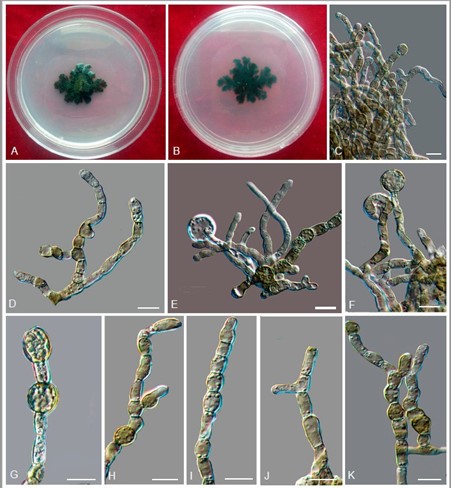Anthracina ramosa L. Su, W. Sun and M.C. Xiang, sp. nov.
MycoBank number: MB 810884; Index Fungorum number: IF 810884; Facesoffungi number: FoF (Figure 6)
Etymology: ramosa (Lat., fem. adj.), referring to the frequently branched hyphae.
Type: China: Henan Province: Nanyang City, Xichuan County, 33◦09j N, 111◦29j W, 757 m a.s.l., from limestone in karst formations, 14 October 2012, Lei Su, (HMAS245363 (dried culture)—holotype and CGMCC 3.16372—ex-type culture).
Description: Hyphae moniliform, branched, smooth, 2.2–5.4-µm (x = 3.9 µm, n = 20)-wide, enteroblastically proliferating, hyaline at first, yellowish brown in age (Figure 6C,D,H–K). Swollen cells spherical to ellipsoidal, 8.6–17.8 µm (x = 13.4 µm, n = 10) in diam., formed intercalarily or terminally (Figure 6E–G).
Culture characteristics: Colonies on MEA growing slowly, attaining 14-mm-diam. after 20 weeks at 25 ◦C, greyish-brown, lobate margin irregular, aerial mycelia scant, and velvety; black in reverse (Figure 6A,B). Minimum 4 ◦C, optimum at 20–25 ◦C, and maximum 30 ◦C.
Additional specimens examined: China: Henan Province: Nanyang City, Xichuan County, 33◦09j N, 111◦29j W, 757 m a.s.l., from limestone in karst formations, 14 October 2012, Lei Su, living culture CGMCC 3.16367. China: Gansu Province: Dunhuang City, Dunhuang Desert, 40◦09j N, 94◦40j W, 2435 m a.s.l., from limestone, 6 October 2010, Lei Su, living culture CGMCC 3.16375.

Figure 6. Anthracina ramosa (CGMCC3.16372). (A,B) Colony forward and reverse after 20 weeks on malt extract agar (MEA). (C,D,H–K) Moniliform and cylindrical celled hyphae. (E–G) Terminal and intercalary swollen cells. Scale bars (C–K) = 10 µm.
